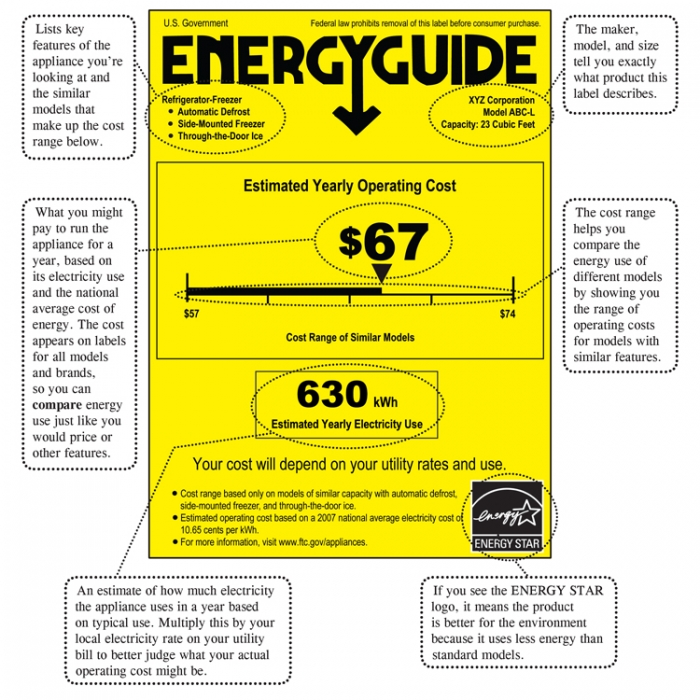All major home appliances must meet the Appliance Standards Program set by the US Department of Energy (DOE). Manufacturers must use standard test procedures developed by DOE to prove the energy use and efficiency of their products. Test results are printed on yellow Energy Guide labels (pictured below) which manufacturers are required to display on many appliances. This label provides the necessary information to perform a Life Cycle Analysis when comparing different models.
Instructions: View detailed descriptions about the information found on Energy Guide labels.
The Federal Trade Commission's Appliance Labeling Rule requires appliance manufacturers to put these labels on refrigerators, freezers, dishwashers, clothes washers, water heaters, furnaces, boilers, central air conditioners, room air conditioners, heat pumps, and pool heaters. The law requires that the labels specify:
- the capacity of the particular model—for refrigerators, freezers, dishwashers, clothes washers, and water heaters;
- the energy efficiency rating and the estimated annual energy consumption of the model—for air conditioners, heat pumps, furnaces, boilers, and pool heaters;
- the range of estimated annual energy consumption, or energy efficiency ratings, of comparable appliances.
How to Use the Labels
A worksheet on how to use the labels in choosing a cost-effective and environmentally friendly appliance is given below.
| Part A - General Information | |
|---|---|
| 1. Are the appliances comparable in size and features? | Answer has to be yes |
| 2. What is the price of the more energy- efficient model? | $ ________ |
| 3. What is the price of the less energy-efficient model? | $ ________ |
| 4. What is the price of electricity in your region? | $ ________ / kWh |
| 5. How long do you expect to keep the appliance? What is the life of the Appliance? | ________ |
| PART B - Determining why you should buy an energy efficient model | |
| 1. Calculating the price difference: | |
| 2. Price of the more energy-efficient model | $ ________ |
| 3. Price of the less energy-efficient model | $ ________ |
| 4. Price Difference | $ ________ |
| Determining the annual energy savings | |
| 1. Annual energy consumption of the less energy-efficient model | ________ kWh |
| 2. Annual energy consumption of the more energy-efficient model | ________ kWh |
| 3. Annual energy savings | ________ kWh |
| Determining the savings | |
| 1. Annual energy savings | ________ kWh |
| 2. Annual monetary savings on energy (energy savings x price) | $ ________ |
| 3. Energy savings over the life time of the appliance | ________ kWh |
| (Life in years x annual energy savings) | |
| 1. Cost of energy savings over life time of the appliance | $ ________ |
| Determining the Pay Back Period | |
| 1. Price difference between the models | $ ________ |
| 2. Annual monetary savings on energy (energy savings x price) | $ ________ |
| 3. Pay Back Period (years to recover the additional investment ) | $ ________ |
| 4. Monetary savings on energy over the lifetime | $ ________ |
| 5. Price Difference | $ ________ |
| 6. Total monetary benefit for choosing environmentally friendly appliance (4 – 5) | $ ________ |
